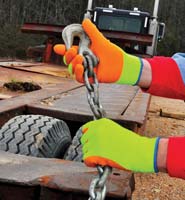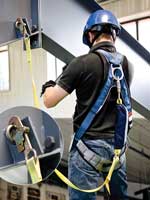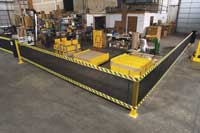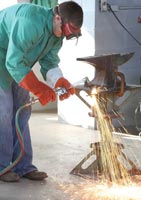
April 2009
- HEALTH & WELLNESS: 12 Steps to Total Health
- IGCC SECTION & INCENTIVES: Timely Tools for Employers
- FALL PROTECTION: Incompatibility Can Kill
- FIRE SAFETY: Controlling Hot Work Hazards
Click here to subscribe.
Features
By Giovanni Henssen
Determining the level of hand protection performance required in a safety glove is critical to the right glove specification. However, different standards and different test methodologies are in use, which can be confusing and complex for safety managers. It is imperative that buyers and safety managers of gloves seek out expert advice and counsel to help them make sense of the different and often incomparable data available.

By Linda J. Sherrard
Occupational foot protection is very often ignored until a serious injury occurs. Safety professionals should take the following steps to ensure their facilities and employees are following best practices when it comes to foot protection.

By Jonathan Klane
Both wellness and workplace occupational health and safety (OHS) have benefits to employees and employers alike. While both can be implemented separately, there are proven additional benefits to combining the two programs into one overall Employee Health, Safety, and Wellness (HSW) Program where the total is greater than the sum of the parts. Combine your efforts in these 12 areas and enjoy improved wellness.
By Marc Barrera
In the midst of changes taking place throughout the health care industry, many OHNs are rightly feeling they are in a whole new profession, which helps explain why organizers of this year's annual AAOHN conference have for months now been plugging the event with the tagline "It's a Whole New Symposium."

By Donald F. Groce
Statistics show the percentage of injuries involving lacerations is considerably higher for the construction industry than for all other industries. And yet, despite the availability of comfortable, cut-resistant gloves, it is not unusual for most construction workers to go gloveless for at least part of the work day.

By W. David Lough
Both lifelong users and those just introduced to fall protection equipment struggle with hardware compatibility. Unfortunately, there are cases where workers using equipment designed according to American National Standards Institute (ANSI) standards have been seriously injured or have died as a result of incompatible connections.

By Andy Olson
When combined with a well-designed safety plan, industrial safety barriers greatly minimize the risks associated with a host of potentially disastrous accidents that threaten the safety and productivity of virtually any fast-paced industrial environment.

By Russ Tanner
Hot work continues to be a leading cause of industrial fires, consistently in the top five across all industries, and it has been responsible for many of industry's most severe fire losses.
Departments
By Robert Pater
Michael Sears is a soft-tissue injury reduction specialist. He's one of the (too few, from my experience) exceptional breed of chiropractic physicians who, rather than focusing on scheduling ever-ongoing sessions with clients, instead emphasizes self-care and personal control of well-being. Perhaps this is because he's also a restorative Yoga instructor.
By Donna Pearson Chadwick
Anyone can write a safety program, but it takes a real commitment on the behalf of everyone involved to create and implement a complete safety culture. The goal of developing a safety culture is to instill the qualities that motivate workers to strive to achieve safety excellence and can be developed only if all on staff work together. Just as a group is only as strong as its weakest member, your staff is only as safe as the least-concerned worker.
By Jerry Laws
Would an online engineering analysis of fall protection anchor points really work? Who needs it? OH&S Editor, Jerry Laws, asked those questions before seeing a demo of the Anchor Point Evaluation Program from Fall Protection Professionals, Inc.'s Jeffrey B. Reep, P.E., the Green Bay, Wis., company's senior structural engineer and developer of the program. What he demonstrated was the initial release, which evaluates the steel supports of fixed or mobile anchoring systems. Timber and concrete add-on modules are scheduled to be released later this year, Reep said.